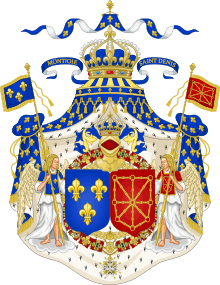Montjoie

Montjoie (Old French Munjoie) is the historical battle cry supposedly used under Charlemagne and later in the medieval Kingdom of France, where it was at some point, presumably in the 12th century (Louis the Fat) - extended to Montjoie Saint Denis in reference to the Oriflamme battle standard, which was originally kept in the Abbey of St. Denis.
The etymology of the term is uncertain. It is first recorded in the Song of Roland (12th century). One commonly cited suggestion connects it to a term for marking stones or cairns set up on the roadside, in Late Latin known as mons Jovis, which from c. 1200 in French appears as monjoie; also connected is the name Mons Gaudii, given by medieval pilgrims to Rama, a point north-west of Jerusalem from the top of which approaching pilgrims would get their first glance of the city.
The name for the 'cairns' has also been proposed as from a Germanic source, mund gawi, supposedly used as a battle cry in a sense of "hold the line"; alternatively from mund galga, from mund "protect" and galga "cross, rood" (as pilgrims would often affix crucifices to these stones);[1] yet another suggestions would derive the term from a Gaulish mant- "path" and gauda "pile of stones". A Mons Jovis or Mons Gaudii is also associated with the martyrdom of Saint Denis (now Montmartre, i.e. "mount of the martyr", but reportedly from an earlier Mons Martis rather than Mons Jovis). Other proposed etymologies include meum gaudium (mon joie), suggesting that the connection between the Carolingian oriflamme and Saint Denis is entirely secondary (Capetian).
References
- ↑ Saint-Allais 1816: Ce qu'on a de plus sensé sur cette matière se réduit à remarquer qu'on appelait autrefois Mont-Joye un monceau de pierres entassées pour marquer les chemins ; sur quoi le Cardinal Huguet de Saint-Cher rapporte la coutume des pèlerins, qui faisaient des Mont-Joyes de monceaux de pierres sur lesquels ils plantaient des croix aussitôt qu'ils découvraient le lieu de dévotion où ils allaient en pèlerinage [...] Or, comme ces Mont-Joyes étaient destinés à marquer les chemins, de même, quand nos rois eurent pris Saint-Denis pour protecteur du royaume, et sa bannière ou l'oriflamme pour bannière de dévotion dans les armées, cette bannière devint le Mont-Joye qui réglait la marche de l'armée [...] Il est bon aussi d'observer que ce cri de guerre n'a été introduit dans nos armées que vers le règne de Louis-le-Gros, qui, ayant réuni en sa personne le comté de Vexin à la couronne, devint avoué de l'église de Saint-Denis, en prit la bannière, de laquelle est venu le cri d'armes.
- Gabrielle M. Spiegel, 'The cult of St. Denis and Capetian kingship' in Wilson (ed.) Saints and Their Cults: Studies in Religious Sociology, Folklore and History, 1985, p. 153
- Joseph J. Duggan, A Guide to Studies on the Chanson de Roland, DS Brewer, 1976, pp. 53f.
- Nicolas Viton de Saint-Allais, Dictionnaire encyclopédique de la noblesse de France, s.v. Mont-Joye-Saint-Denis, Paris, 1816